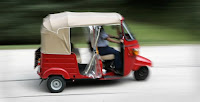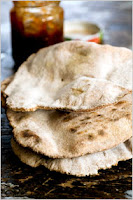 I've now created a separate page for some of the video clips I shot while in India. You can view them here.
I've now created a separate page for some of the video clips I shot while in India. You can view them here.
Monday, September 15, 2008
Video Clips
 I've now created a separate page for some of the video clips I shot while in India. You can view them here.
I've now created a separate page for some of the video clips I shot while in India. You can view them here.
Thursday, August 21, 2008
My Photographs from the Trip
I've now finished putting together a website containing some of my favorite photographs from the trip. You can access the site here. The photographs are divided into groups -- they really kind of sorted themselves out: People, People at Work, Streets, Signs, Facades (doors and windows), Mosques, Temples, and Villages.
Friday, August 15, 2008
Exploring India’s Prosperity Through the Eyes of the Invisible Men
Another article on India from The New York Times focusing on the enormous economic and class divisions there. It's written by Anand Giridharadas and also appears in The International Herald Tribune. The article discusses a new movie, “Barah Aana,” which features a servant's view of class division in India (reminiscent of Aravind Adiga's The White Tiger, which the author doesn't mention). The article quotes the director as saying India may have a problem deeper than "poverty": a "'dehumanization' problem." This is a little vague, but it seems to me it may allude to the entrenched effects of the caste system in India and how it has helped to structure the effects of modern capitalism.
Thursday, August 14, 2008
Make Your Own Chapati: Part II



A couple of days ago I posted Mark Bittman's recipe for making chapati on the grill. I'm here to tell you it works. The first picture above is a shot of the four pieces of dough I rolled out, ready to go on the grill. The second shot is of a piece that's done and ready to come off the grill. He's right that it only takes about a minute a side--once the first side puffs up and begins to darken you just flip it over, then the second side will puff up and darken, and it's done. They were quite good, but next time I'm going to use more white and less wheat flour because I think wheat flour in the States is more grainy and "wheaty" tasting than what I had in India.
Of course in India the women I saw making chapati didn't use food processors to work their dough. They did it all by hand, and with artful dexterity and speed. Nor did they use rolling pins to shape and flatten the pieces of dough before they were cooked on a pan over an open flame (Bittman recommends using a tortilla press, which would be a heresy worse than the rolling pin). They would just work the dough in their hands for a while, then flatten it out with one hand on a stone or board with quick, rhythmic patting motions. The third picture here was taken in the small kitchen of a woman who made lunch for us in a little village outside of Pune. She let me try to make chapati with her and I failed miserably. But I remember squatting there watching her work and being taken by the rhythmic, musical sound of her patting the dough flat with one had. It was like she was playing a little drum and I began to clap along with her, and then did a little scat singing to try to indicate how musical her work was.
‘Auto rickshaw’ Gives Waukesha Man Cheap, Fun Ride
 Thanks go to my brother, Greg, who lives in Milwaukee, for spotting this article in today's Milwaukee Journal Sentinel about a guy who has bought and imported his own autorickshaw. Paulo are you out there? You can read the article here.
Thanks go to my brother, Greg, who lives in Milwaukee, for spotting this article in today's Milwaukee Journal Sentinel about a guy who has bought and imported his own autorickshaw. Paulo are you out there? You can read the article here.
Wednesday, August 13, 2008
Make Your Own Chapati--on the Backyard Grill!
 Those of you who have been following this blog know I tried my hand at making chapati a few times on the trip, sometimes successfully, sometimes not. Chapati is one of the traditional flat breads of India. It's usually cooked quickly in a hot pan, though at Navdanya I saw the cook throw pieces right on the burner after they came out of the pan to make them bubble up. But in today's New York Times the inimitable Mark Bittman has published a simple recipe for making chapati on the barbecue grill. Here it is:
Those of you who have been following this blog know I tried my hand at making chapati a few times on the trip, sometimes successfully, sometimes not. Chapati is one of the traditional flat breads of India. It's usually cooked quickly in a hot pan, though at Navdanya I saw the cook throw pieces right on the burner after they came out of the pan to make them bubble up. But in today's New York Times the inimitable Mark Bittman has published a simple recipe for making chapati on the barbecue grill. Here it is:Grilled Chapatis
2 1/4 cups whole wheat flour
1 cup all-purpose flour, more for dusting
1 teaspoon salt.
1. Mix flours in food processor; add salt and, with machine running, pour in one cup warm water. Process for about 30 seconds, then remove cover. Dough should be in a well-defined, barely sticky, easy-to-handle ball. If it is too dry, add warm water a tablespoon at a time and process for 5 to 10 seconds after each addition. If it is too wet, which is unlikely, add a tablespoon or two of flour and process briefly.
2. With floured hands, shape dough into a ball, cover with plastic and let rest for at least 30 minutes. (At this point, you may wrap dough tightly in plastic and refrigerate it for up to a day; bring to room temperature before proceeding.)
3. When ready to grill, pinch off a piece of dough and roll as thin as is practical. Dust lightly with flour to keep from sticking and cover with plastic or a damp cloth while you roll out remaining dough. (It is O.K. to overlap them a bit, but do not stack them.) Or just roll as you grill.
4. Grill chapatis until they start to blister, char and puff up a bit, about a minute or so. Turn and repeat. Serve immediately.
Yield: 8 to 12 chapatis, 4 to 6 servings.
Click here for the complete article.
Saturday, August 9, 2008
Interview with Ashish Nandy
 Anil Lal, Vinay Lal's brother, has sent me the link to a recent interview with Ashish Nandy. You'll find it by clicking here. In the interview he is very critical of the impact of modernization and secularization on India, insists that Gujarat has become a kind of intellectual and cultural waste land, laments that the middle class do not have middle class values and lack "the modern concept of cosmopolitanism," discusses the reemergence of religion as a dominant force, and talks about how, in his disillusionment after the Emergency, he found himself re-evaluating Gandhi: "I began to look for new ways of looking at Indian politics. My discovery of Gandhi happened at that time. I had always disliked Gandhi: his allegiances had looked primordial; his style a deviation from our idea of cosmopolitanism; his politics anti-modern. But I rediscovered Gandhi. I became more sceptical of the Indian state, which was modelled on the colonial state that had ruled us. I saw that the categories that dominated Indian politics had no openness to the experiences of a majority of Indians." It's an uncompromising articulation of his position.
Anil Lal, Vinay Lal's brother, has sent me the link to a recent interview with Ashish Nandy. You'll find it by clicking here. In the interview he is very critical of the impact of modernization and secularization on India, insists that Gujarat has become a kind of intellectual and cultural waste land, laments that the middle class do not have middle class values and lack "the modern concept of cosmopolitanism," discusses the reemergence of religion as a dominant force, and talks about how, in his disillusionment after the Emergency, he found himself re-evaluating Gandhi: "I began to look for new ways of looking at Indian politics. My discovery of Gandhi happened at that time. I had always disliked Gandhi: his allegiances had looked primordial; his style a deviation from our idea of cosmopolitanism; his politics anti-modern. But I rediscovered Gandhi. I became more sceptical of the Indian state, which was modelled on the colonial state that had ruled us. I saw that the categories that dominated Indian politics had no openness to the experiences of a majority of Indians." It's an uncompromising articulation of his position.If you read it, feel free to comment here as a way to extend the discussions we began to have on the trip.
Subscribe to:
Posts (Atom)